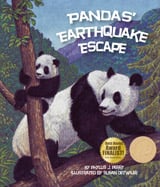Alignment to Standards for CA

| Grade | Number | Standard |
|---|---|---|
| 1 | 1 S LS--2 | Plants and animals meet their needs in different ways. |
| 1 | 1 S LS--2.a. | Different plants and animals inhabit different kinds of environments and have external features that help them thrive in different kinds of places. |
| 1 | 1 S LS--2.c. | animals eat plants or other animals for food and may also use plants or even other animals for shelter and nesting. |
| 1 | 1 SS 2)1 | Locate on maps and globes their local community, California, the United States, the seven continents, and the four oceans. |
| 2 | 2 S LS--2 | Plants and animals have predictable life cycles. |
| 2 | 2 S LS--2.a. | organisms reproduce offspring of their own kind and that the offspring resemble their parents and one another. |
| 2 | 2 S LS--2.b. | sequential stages of life cycles are different for different animals, such as butterflies, frogs, and mice. |
| 2 | 2 S LS--2.c. | many characteristics of an organism are inherited from the parents. Some characteristics are caused or influenced by the environment. |
| 2 | 2 SS 2) | demonstrate map skills by describing the absolute and relative locations of people, places, and environments. |
| 2 | 2 SS 2)1 | Locate on a simple letter-number grid system the specific locations and geographic features in their neighborhood or community (e.g., map of the classroom, the school). |
| 3 | 3 S LS--3 | Adaptations in physical structure or behavior may improve an organisms chance for survival. |
| 3 | 3 S LS--3.a. | plants and animals have structures that serve different functions in growth, survival, and reproduction. |
| 3 | 3 S LS--3.c. | living things cause changes in the environment in which they live: some of these changes are detrimental to the organism or other organisms, and some are beneficial. |
| 3 | 3 S LS--3.d. | when the environment changes, some plants and animals survive and reproduce; others die or move to new locations. |
| 3 | 3 SS 1) | physical and human geography and use maps, tables, graphs, photographs, and charts to organize information about people, places, and environments in a spatial context. |
| 3 | 3 SS 1)1 | Identify geographical features in their local region (e.g., deserts, mountains, valleys, hills, coastal areas, oceans, lakes). |
| 4 | 4 S ES--5.a. | some changes in the earth are due to slow processes, such as erosion, and some changes are due to rapid processes, such as landslides, volcanic eruptions, and earthquakes. |
| 4 | 4 S LS--2.b. | producers and consumers (herbivores, carnivores, omnivores, and decomposers) are related in food chains and food webs and may compete with each other for resources in an ecosystem. |
| 4 | 4 S LS--3 | Living organisms depend on one another and on their environment for survival. |
| 4 | 4 S LS--3.b. | in any particular environment, some kinds of plants and animals survive well, some survive less well, and some cannot survive at all. |
| 4 | 4 SS 1)1 | Explain and use the coordinate grid system of latitude and longitude to determine the absolute locations of places in California and on Earth. |
| K | K S LS--2 | Different types of plants and animals inhabit the earth. |
| K | K S LS--2.a. | similarities and differences in the appearance and behavior of plants and animals (e.g., seed-bearing plants, birds, fish, insects). |
| K | K S LS--2.b. | stories sometimes give plants and animals attributes they do not really have. |
| K | K S LS--2.c. | identify major structures of common plants and animals (e.g., stems, leaves, roots, arms, wings, legs). |
| K | K SS 1) | being a good citizen involves acting in certain ways. |
| K | K SS 4)2 | Distinguish between land and water on maps and globes and locate general areas referenced in historical legends and stories. |